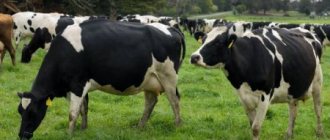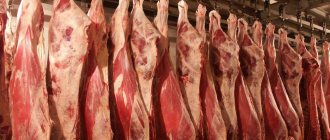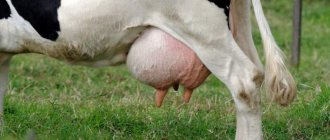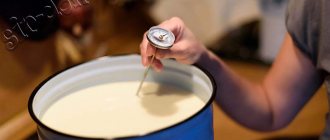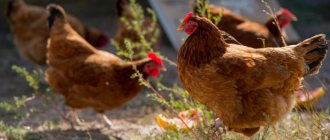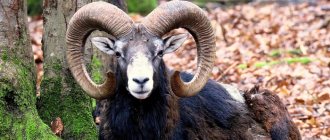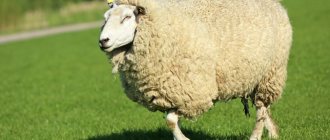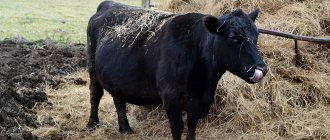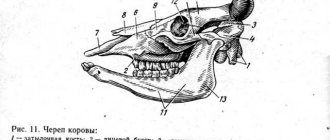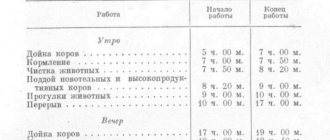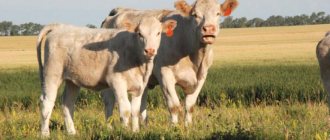General concepts of the procedure and its meaning
Grading is understood as a series of actions that make it possible to understand the capabilities of a farm for the production of meat and dairy products and to select cattle that are most suitable for breeding.
The process consists of a number of activities, including:
- determination of the breed of cattle;
- assessing the structure and external data of the animal, its compliance with the breed and direction;
- productivity assessment.
One of the main purposes of grading is to improve the breed. Therefore, priority attention when carrying out activities is given to animals that are (or will be) used to increase the number of cows in the herd. The optimal indicator is the presence of at least 25 replacement heifers per hundred cattle each year.
The procedure is carried out by livestock specialists involved in breeding work. If necessary, people who are well aware of the characteristics of various breeds are invited to conduct events.
In most farms, they only collect the necessary information, which is subsequently processed by a computer (special program “Selex”).
Purpose of bonding
According to the order of the Ministry of Agriculture No. 402 dated October 19, 2006, bonding should be carried out to identify the best individuals in the herd in order to improve the breed. Summary reports must be sent to Rossat no later than October 1.
Example of completed research work aimed at studying stud bulls
It is necessary to create a special commission, which should study all the documents and each individual separately. All data is compiled in the form of tables for each animal. The submitted documents must have the signature of the responsible persons. They are also certified by a seal.
Rules and execution algorithm
All activities included in the assessment are regulated by special instructions. The document defines workover standards.
Before the start of grading, livestock specialists carry out preparations, which include work on:
- checking the numbers assigned to animals;
- taking into account information about the conditions of keeping cattle and the feed used;
- filling out a special card form F2-mol;
- calculating the milk yield of each female for a certain period of time.
Cows must be graded at least once a year. To work more efficiently, the herd is “divided” into groups for the purpose of inspection, weighing and other procedures. Animals are checked at the end of the feeding period, young animals - from the moment the individuals reach physiological maturity, and bulls and heifers for fattening - from 10 months. The assessment method is adjusted depending on the gender of the cows and their main purpose.
After all the activities have been carried out, the obtained data is verified with a special table. All collected information is endorsed and certified with seals.
Preparatory activities
Before you start grading, on the farm:
- check livestock for inventory numbers to identify lost or unclear ones;
- systematize information about housing and feeding;
- milk yields for cows are summed up for the last 305 days;
- fill out cards F2-mol.
Basic requirements at the time of assessment
For each group of cattle, certain criteria have been developed by which animals are assessed. When evaluating cows, the following are taken into account:
- Milk productivity of an individual. To do this, the milk yield is calculated for three hundred days of lactation, or for a shortened lactation, if there was one. The average fat content of the milk obtained from it is also calculated.
- Suitable for machine milking.
- Constitution of the body.
- Exterior of the animal.
- Genotype (pedigree).
- Weight (cows are weighed 2-5 months after calving).
- Reproductive ability.
When evaluating bulls, the purity of the breed (genotype) and the quality of the offspring they produce come first. In the latter case, young animals received from the producer and reaching 6 months of age at the time of grading are taken into account. In addition, the appearance of the cow is subject to evaluation.
The criterion for young individuals is development and appearance features.
Dairy and beef cows are valued completely differently. Requirements for young animals will be reduced.
Document overview
A draft order has been presented, which approves the procedure and conditions for the assessment of pedigree sheep of the Romanov breed.
It is stipulated that it is carried out to determine the assessment of the breeding and productive qualities of breeding animals for the purpose of their further use annually (within a year) after shearing. Young animals undergo preliminary grading before being sheared.
Sheep valuation is carried out in all organizations that have this product (material).
It is carried out by livestock breeders who have special training or practical experience in grading Romanov breed sheep. In breeding organizations, representatives of regional tribal service bodies, specialists from research and educational institutions are involved for this purpose.
Summary reports of valuation results are prepared annually as of January 1.
To view the current text of the document and obtain complete information about the entry into force, changes and procedure for applying the document, use the search in the Internet version of the GARANT system:
Breed definition
Documents are the basis for determining the breed of an animal. Moreover, not only the documents of a particular individual are studied, but also the documents of its parents. In this case, the animal must correspond to its breed in terms of external characteristics, productivity and a number of other characteristic features.
A cow is considered purebred if both parents belong to the same breed (for example, Aishir, Russian Black and White).
In addition, animals obtained by crossing purebred individuals of different breeds are recognized as purebred.
In this case, calves from animals of the same root are included in the group of improved varieties. To determine the breed when crossing, a table with data is used.
The group of mixed breeds includes offspring obtained from:
- from individuals belonging to completely different breeds;
- from crossing pure breed cattle with local livestock;
- as a result of breeding “in itself”.
The latter method is the breeding of animals through the mating of interbreed crosses, if they meet the requirements for them.
If an animal does not have documents confirming its breed, it is classified as a crossbreed of the 1st or 2nd generation.
Reproduction
Suffolks are productive, and when crossed with other breeds they produce crosses with improved meat qualities. Intrabreed characteristics remain unchanged. Females give birth every year. For mating, the strongest, well-fed rams, as well as healthy sexually mature sheep, are selected. A six-month-old sheep is considered sexually mature. Mating occurs in August-October. Pregnancy lasts 5 months.
Fertilization occurs naturally: males are released to females for insemination during the day, and separated at night, or the rams remain constantly nearby so that it can happen at any time. During cervical insemination, the seminal fluid of a sheep is injected into the uterine cavity using a special syringe-catheter.
Exterior
Exterior is the external structure of a cattle's body. This indicator allows us to establish how pronounced the characteristics of the breed are in a particular individual and to identify the characteristics of the animal. Also, by the exterior, one can judge the direction of livestock productivity, the state of health of the individual, and suitability for certain purposes, including the conditions of industrial technology.
The exterior is assessed by individual parts of the animal’s body. These parts of animal science are called articles. As a rule, the assessment of the exterior begins with the front part of the body, while assessing all defects and deviations (or the absence thereof). During the examination, the animal is given a score from “1” to “5”. Among the “excellent students” are individuals who have:
- well developed withers for age;
- wide chest;
- straight sacrum, back and lower back;
- developed pelvis;
- correctly positioned limbs.
In addition, in heifers (especially dairy heifers), the shape and size of the udder is assessed, as well as their suitability for machine milking. At the same time, the general fatness of dairy animals should be below average, they should not have fat deposits.
Animals are graded according to their exterior from the first month of a calf’s life. Young animals under the age of 2 years are assessed in 5 categories, attention is paid to the absence of pathological abnormalities and deformations. For older individuals, breed and productive characteristics come first when evaluating.
Cattle grading: where to start
This process must be completed every year. Individuals who have not reached 6 months of age, castrated animals and a group of individuals put for fattening are not subject to bonding.
The initial stage is as follows:
- summing up the assessment of productivity (producers are assessed by the quality of young animals that have reached 6 months at the time of bonding);
- preparation of information on inventory numbers of cattle;
- determination of measurements;
- carrying out weighing before morning feeding;
- checking for pregnancy and the presence of pathologies in the reproductive system;
- clarification of breeding records.
For research to be effective, it must include data on the health status of cattle.
Thus, it is necessary to prepare all the books that contain information about the animals being studied. You will also need to provide veterinary certificates confirming the availability of the required vaccinations and the health status of the livestock. Therefore, a veterinarian should always work on a livestock farm. Any changes in the animal's health must be recorded in the appropriate book. You can read below about what vaccinations are given to cattle and in what order they follow each other.
It is also necessary to provide the commission with information about feeding and maintenance and F-2 cards. In order not to have to do all the preparatory work for a long time, you need to fill out everything as you receive information.
Prices for Premix for calves
Estimation by live weight
Another criterion used when assessing cattle individuals is live weight. It is taken into account that animals of meat breeds gain maximum weight early, while representatives of dairy breeds maintain its optimal parameters for a long time.
You can measure live weight using scales. Animals are weighed daily, and the data obtained is recorded in a special book.
Another option for determining live weight is to take measurements. This method is based on the fact that the body weight of cattle is proportional to its volume. For measurements in this case, a measuring tape or stick is used.
To obtain the live weight value of an animal, the oblique length of the body is measured (from the most anterior point of the protrusion of the humerus to the posterior protrusion of the ischial tuberosity) and chest girth (measured behind the shoulder blades). The measurement results are checked against the table. This measurement of live weight gives an error of no more than 20-30 kg compared to weighing.
Live weight is assessed for all groups of cattle: young animals, cows and bulls.
Important! The weight of cattle depends not only on age, but also on feeding conditions and even on climatic and weather phenomena. Also, this indicator can be influenced by various animal diseases and a number of other factors.
Preparation
At the stage of preparation for valuation, it is necessary to draw up republican and regional valuation scales. In this case, objective parameters and characteristics of the soil are used. Soil scientists are involved in the preparation of such documents.
It is important to use statistical data
When compiling grading scales based on soil characteristics and parameters of its productivity, the following types of information are used:
- Soil map, materials from large-scale ground surveys of farms, soil reports with analytics, tables of land areas.
- Climatic information, including average long-term temperature, average annual precipitation, duration of the frost-free period.
- Materials on state registration of land users.
- Literary information regarding the assessment of land in the region.
- Annual reports of collective and state farms for 5 years.
- Information on long-term yields in areas with different types of soil.
Conditions and process of soil formation, what factors influence and scheme and stagesRead
Definition of Productivity
Productivity is the main beneficial property of cattle. It needs to be taken into account first.
The most valuable individuals in terms of milk productivity are considered to be cows that maintain their milk yield annually. These are also those animals that are able to withstand significant physiological stress during lactation for a long period of time.
The assessment is made simultaneously by the quantity of milk and its quality. Until recently, the percentage of fat was considered an indicator of the quality of dairy products. Now the protein content in milk is taken as a basis.
As for representatives of meat breeds, their productivity is assessed both during life and after slaughter. Lifetime assessment is made based on growth intensity, taking into account live weight indicators at different periods of life. The quality of the animal’s exterior also influences the assessment. Attention here is paid to a well-developed back, rump and ham - those parts from which the best grades of meat are obtained.
The final assessment of meat productivity is made after slaughter. Indicators that are taken into account when evaluating: slaughter weight, slaughter yield, the ratio of fat and muscle in the carcass, the histological structure of the muscles, as well as the nutritional value and taste of meat.
What is cattle bonding?
Bonting of cattle is used to study a specific individual. Based on the study, it is possible to identify the exterior, productivity, constitution and origin. The work is carried out by a special bonding commission.
A special commission is involved to study a number of qualities of cattle
To complete the work, it is necessary to prepare all the necessary documentation for all animals. The document is submitted every year to the statistical authorities, which allows us to draw a conclusion about the effectiveness of livestock development in a particular region or in the country as a whole.
This is what is reflected in the bonus tables:
- breed and class composition of the individual;
- information about cattle by milk production and animal body weight for the last 305 days;
- assessment of the shape of the udder and the rate of milk release in dairy breeds;
- information about insemination;
- slaughter data;
- features of industrial use;
- characteristics of young animals that are sold and that are necessary for the repair of the herd;
- the result of using breeding individuals;
- data on the genealogical structure of the herd;
- characteristics of probotnitized individuals.
The data collected by the commission includes information on annual milk production, insemination, slaughter, etc.
Important. All commission members must sign the document for it to have legal force.
Checking offspring
The value of animals can be determined by assessing the offspring. This indicator is used to evaluate both sires and dam cows. At the same time, the former are assessed much more strictly, since each sire annually produces more offspring than the uterus.
An important indicator of the reproductive ability of bulls is the quality (fertilizing ability) of sperm. It is determined by the number of repeated inseminations. If their number is more than 50%, then the animal is excluded from the test.
Bulls are checked already in the first year of life. During the testing period, semen is collected from animals daily. A certain number of cows are inseminated with it. On average, up to 80-100 cows and heifers should be inseminated with the sperm of one bull. After receiving offspring, young cows must be examined.
Important! When assessing the reproductive ability of cows, livestock specialists and veterinarians take as a basis the course of calving and the duration of the period between two pregnancies.
Production and zootechnical accounting
Intensive use of breeding stock is possible only with well-organized production and zootechnical accounting. Such accounting includes information about the origin and breed of animals, mating or insemination with an indication of the manufacturer, indicators of individual development: animal productivity for a certain period and the entire period of use, information about the reproductive abilities, descendants and purpose of the animal.
Production and zootechnical accounting will make it possible to quickly monitor work on farms with careful maintenance of special forms: a log of matings (insemination), launches and calvings, a log of raising young animals, a log of breeding stock, a log of milk yield and fat content in milk, as well as logs of primary productivity accounting, assessment sheets, etc. Production and zootechnical accounting is impossible without tagging, that is, clear numbering of animals. They are marked using ear tags, burning on the horns, forehead tags, collars, and applying an individual number on the body, shoulder blade, hip or other parts of the body. Animals are marked in different ways: cooled in liquid nitrogen or heated with specially made numbers, plucking on the ears, tattooing, indelible paint, felting, so that the number remains on the animal throughout its life.
Recently, animal tagging contains not only information about the individual number of the animal, but also about the level of productivity, stage of lactation, state of reproduction - such information allows you to control the organization and production of livestock products, and manage production processes in livestock farming.
A number of farms successfully use a special accounting system called “Kartoteka” for this purpose. It consists of a card index for pregnant, new-calving and highly productive cows, as well as those subject to insemination, and a calendar for the artificial insemination technician. All current processes in the herd are entered into individual cow cards, which are then placed in chronological order by date in the appropriate cells of the cards. Each card serves as a storage unit for an array of animal cards with a relatively identical (accuracy of 10 days) functional state.
To analyze the work in the herd in breeding and reproduction using computer technology, the adopted SELEX system (selection, economics, system) is being introduced. The forms of breeding and zootechnical accounting forms provided for by this system and current accounting (magazine of artificial insemination, launch and calving of cows and inseminated heifers, card of registration of insemination and calving of cows (heifers) and gynecological card) can be produced upon request by republican and regional Soyuzuchetizdatelstvo " The country has created a network of machine counting stations, systems of the Central Statistical Office of the USSR, and specialized computer centers at institutes. The centers have electronic computers (computers) and have some experience in using computer technology for production and zootechnical accounting. With the introduction of computers, specialists are freed from labor-intensive accounting processes, operational information is received faster and the efficiency of breeding work is significantly increased.
Work using computer technology is carried out using special methods, which include: the form of supply of materials, the purpose of their processing and the processing program. Farms keep a card where primary records are entered for each animal from birth to disposal. The cards are periodically sent to computer centers for processing and then returned to the farms.
Production and zootechnical accounting is carried out in such a way as to reflect all production activities of farms, complexes, specialized farms and make it possible to control work on selection and breeding indicators, reproduction and determine material and moral incentives for rewards for the work performed.
What are the classes of cows?
At the end of the assessment, the indicators for all criteria are summed up and the final assessment is obtained. The maximum number of points that animals can score based on the results of grading is 100. In this case, the highest score for performance is 60, for external data - 24, and for genotype - 16. Based on this final result, animals are divided into classes.
According to the instructions of the Ministry of Agriculture, the following classification is used for adult cattle:
- Record elite. This group includes animals that scored at least 81 points.
- Elite group. This includes individuals with a minimum score of 71 to 80 points.
- 1st class is established for cattle that have scored up to 70 points.
- Class 2 is determined for an animal that scores up to 60 points.
Cows scoring less than 50 points do not belong to any class. Such animals are not recommended for use to produce offspring. And in terms of productivity, they are usually of little benefit.
As for young animals, there is another scale for them, according to which:
- animals that score 40 or more points belong to the elite record class;
- 35-39 points – to the elite class;
- 30-34 points – to grade I;
- 25-29 – to class II.
A cow cannot always belong to the same class, since its indicators change. At the same time, they can either improve or worsen.
Instructions for grading cattle of dairy and dairy-meat breeds
I. ORGANIZATION OF GRADING AND SIGNS CONSIDERED WHEN ASSESSING LIVESTOCK
1. In order to determine the breeding value and purpose of animals on farms, at artificial insemination stations, and breeding enterprises, all sires, cows, replacement heifers and breeding bulls are assessed annually. 2. Cattle are graded throughout the year: replacement bulls upon reaching breeding age, cows at the end of lactation, young animals from 10 months of age. 3. Livestock assessment is carried out by livestock breeders of farms, state breeding stations (state breeding associations) and state breeding nurseries. In some cases, grading can be carried out by invited specialists and researchers from agricultural research institutions and educational institutions who know the breed well. 4. To carry out grading: - calculate the milk yield of each cow for 305 days of the last lactation (or for a shortened lactation) and calculate the average fat content of milk; - evaluate animals based on their appearance and constitution; — determine the suitability of cows for machine milking; - weigh each animal (cows 2-5 months after calving); — check the inventory numbers of animals; unclear or lost ones are renewed. 5. When grading, a comprehensive assessment of animals is carried out according to breed and origin, productivity and development, exterior and constitution, quality of offspring, milk production properties of cows; take into account the reproductive ability of producers and queens.
II. DETERMINATION OF CATTLE BREED
6. The breed of animals is determined on the basis of a document about their origin and the breed of their parents with a mandatory examination of the animals. Based on breed (blood) there are groups of purebreds and crossbreds. 7. Not applicable. 8. Crossbreeds include animals obtained: a) as a result of crossing animals of two breeds, except for the breeds specified in the letter of the Department of Animal Husbandry and Breeding of the Ministry of Agriculture and Food of Russia dated December 31, 1997 No. 18-06/577 “On the procedure for determining the origin (breed) ) breeding animals"; b) when breeding crossbreeds “inside”, with the exception of cases provided for by letter of the Department of Livestock and Breeding of the Ministry of Agriculture and Food of Russia dated December 31, 1997 No. 18-06/577; c) when crossing local cattle with purebred cattle and crossbreeds. The degree of breeding during crossing is determined on the basis of data on origin (Table 1).
Table 1: Determination of the degree of breeding of animals during crossing
| Mother's breed | Father's breed | ||
| purebred | IV generation (blood 15/16) | III generation*(blood 7/8) | |
| Animal breed level | |||
| Purebred | Purebred | — | — |
| IV generation (15/16) | Purebred | IV generation (15/16) | — |
| III generation (7/8) | IV generation (15/16) or purebred | IV generation (15/16) | III generation (7/8) |
| II generation (3/4) | III generation (7/8) | III generation (7/8) | II generation (3/4) |
| I generation (1/2) | II generation (3/4) | III generation (3/4) | II generation (3/4) |
| Local | I generation (1/2) | I generation (1/2) | I generation (1/2) |
* Third generation sire bulls can be used in herds of commercial farms with the decision of the regional (territorial) department of agriculture or the Ministry of Agriculture of the Union Republic.
9. In the absence of documents about the origin and the presence of a well-defined type of improving breed in animals, they are classified as crosses of the 1st-2nd generations (1/2-3/4 blood) of this breed. 10. During introductory crossing, the breed of animals is established as follows: a) the offspring obtained from crossing animals of two original breeds are classified as the 1st generation; b) the offspring obtained from crossing crosses of the first generation with purebred animals of the improved breed (backcrossing) are classified as second generation (3/4 blood) according to the maternal breed; c) the offspring obtained from crossing crosses of the second generation with purebred animals with the expression of the type planned according to the plan are classified as purebred (based on the maternal breed); d) the offspring from breeding crosses of the second generation (3/4 blood) “in themselves”, depending on the severity of the type planned according to the plan, are classified as crosses of the third or fourth generation of the improved breed. The offspring from breeding crosses of the 3rd and 4th generations, depending on the severity of the desired type, are classified as the 4th generation or purebred.
III. ASSESSMENT OF COWS BY MILK PRODUCTIVITY
11. Cows are assessed for milk productivity by milk yield (kg), fat content in milk (%) or amount of milk fat (kg) for 305 days of lactation or for a shortened completed lactation (Appendix 2 and Appendix 3). Minimum milk yield requirements (Appendix 2) are established for first-calf heifers calving before the age of 30 months. When calving at a later age, milk yield requirements increase by 10%. With shortened lactation, the actual milk yield is taken into account and the duration of lactation is indicated in days. Control milking of cows is carried out at least once a month. (In extract). 12. The average fat content of milk for the first 305 days of lactation or for shortened lactation is determined based on the results of systematic determinations, which are carried out once a month. The average fat content of milk is calculated by multiplying the percentage of fat in milk for each month by the monthly milk yield, the products are added (receiving the amount of one percent milk per lactation) and the amount is divided by the actual milk yield for the same months. The amount of milk fat per lactation (kg) is determined by dividing the amount of one percent milk by 100. (Clause 12 does not apply in breeding farms and in breeding reproducers, see Rules for assessing the milk productivity of dairy-meat cows. SNPplem R 23-97) 13. First calf are assessed by milk yield for the completed lactation, cows of two calvings - by average productivity for two lactations, full-aged cows - by average productivity for any three lactations. On commercial farms, in the absence of data for previous years, it is allowed to evaluate cows based on the last completed lactation. 14. The average milk fat content of cows when assessing their productivity for a series of lactation is calculated by summing the milk yield expressed in one percent milk for the lactations taken into account (305-day or shortened) and dividing this amount of one percent milk by the actual amount of milk produced for the same lactations. 15. To determine the properties of milk production in the 2-3rd months of lactation, control milking of cows is carried out during the day. During control milking, the amount of one-time milk yield (kg) and the time spent on each milking (min) are taken into account. The average milk flow rate is determined in kg/min by dividing the amount of milk produced per day (kg) by the time spent (min). The results of monitoring the milk production properties of cows are recorded in a special sheet (Appendix 5).
IV. ASSESSMENT OF ANIMALS BY EXTERIOR AND CONSTITUTION
16. Cows are assessed for exterior and constitution at the 2-3rd month of lactation of the 1st and 3rd calvings. If the assessment was not carried out after the 1st calving, this will be done after the 2nd calving. Bulls are evaluated annually until 5 years of age. If the animal has not been assessed for its exterior and constitution at the indicated ages, it is assessed during the next assessment. 17. When assessing the exterior and constitution, special attention is paid to the severity of the breed type, harmonious physique, in bulls - on the strength of the lower back and especially the hind legs, in cows - on the size of the udder, its shape and suitability for machine milking. The physique of bulls and cows is assessed on a 10-point scale with an accuracy of 0.5 points. Table 2 and Table 3 show 10-point scales for assessing cows and bulls by exterior. The scoring is supplemented with a mandatory indication of the main defects and shortcomings of the exterior.
Table 2: Rating scale for cows based on appearance and constitution
| General development and statistics | Indicators taken into account when assessing | Point |
| 1. General appearance and development | Proportionality of physique, strength of constitution, expression of breed type | 3 |
| 2. Udder * | Volume, glandularity, shape, milk veins, anterior and posterior nipples, attachment to the body, uniformity of lobe development | 5 |
| 3. Front and rear legs | Strength and positioning of legs, strength and shape of hooves | 2 |
| Sum of points | 10 |
* — There are three main udder shapes: cup-shaped, rounded and goat.
Table 3: Rating scale for stud bulls based on exterior and constitution
| General development and stats | Indicators taken into account when assessing | Point |
| 1. General appearance and development | Proportionality of physique, strength of constitution, expression of breed type, expression of male type, muscles, bones | 4 |
| 2. Exterior statistics | A) head and neck, chest, withers, back, lower back, middle part of the body, butt | 4 |
| B) strength and positioning of the legs - front and rear, strength and shape of the hooves | 2 | |
| Sum of points | 10 |
18. The assessment of young animals in terms of exterior is carried out on a five-point scale: excellent - 5, good - 4, satisfactory - 3, unsatisfactory - 2, bad - 1. The five-point rating can be clarified by using half points (4.5; 3.5). An excellent rating (point 5) is given to an animal with good expression of the characteristics of breed and sex, good development and growth, excellent development of the chest (wide, deep, without interception behind the shoulder blades), straight line of the back, lower back, sacrum, well-developed pelvis, correct positioning of the legs and strong bones, without overdevelopment and roughness. (Table 4)
Table 4: Disadvantages in the physique of dairy and dairy-meat cattle, for which the score for exterior and constitution is reduced
| General development and statistics | List of disadvantages |
| 1. General development | General underdevelopment. The skeleton is rough or overdeveloped-tender. The muscles are loose or underdeveloped. The physique is disproportionate and does not correspond to the direction of productivity. The breed type is poorly defined. |
| Exterior statistics 1) head and neck | The head is heavy or overdeveloped, bullish for a cow or cowish for a bull. The neck is short, rough with thick folds of skin or notched, weakly muscled. |
| 2) chest | The chest is narrow, shallow, interception and depressions behind the shoulder blades |
| 3) withers, back | The withers are forked or sharp. The back is narrow, short, sagging or humped. The loin is narrow, sagging or roof-shaped |
| 4) middle part of the body | Cows have an underdeveloped belly, bulls have a saggy belly |
| 5) back | Short, drooping, roof-shaped, awl-shaped |
| 6) udder and nipples | The udder is small or pendulous (the distance from the nipples to the ground is less than 45 cm), with unevenly developed lobes |
| 7) front and rear legs | The nipples are short, close together, abnormally developed, unsuitable for machine milking, clause 2.2. Rules for machine milking of cows, ed. 1972 |
V. FINAL ASSESSMENT AND DETERMINATION OF THE CLASS OF ANIMALS BY A COMPLEX OF CHARACTERISTS
19. The final assessment of animals during grading is carried out according to the following criteria: cows - by milk productivity, exterior and constitution, genotype; sires - according to exterior and constitution, genotype; young animals - by genotype, exterior and development. 20. Based on the results of the final assessment, cows, bulls and young animals are classified into classes: elite-record, elite, class I, class II. Animals that do not meet the requirements of class II are classified as non-class animals.
A. Determination of the class of cows 21. The class of a cow according to a set of characteristics is established on a scale (Table 5) in accordance with the sum of points received: elite-record with a score of 80 points and above elite 79-70 points I class 69-60 points II class 59 —50 points
Table 5: Scale for assessing cows based on a set of traits a) milk productivity (60 points in total)
| Productivity level as a percentage of class I requirements (Appendices 2 and 3) | Point |
| 60—69 | 20 |
| 70—79 | 25 |
| 80—89 | 28 |
| 90—99 | 31 |
| 100—109 | 34 |
| 110—119 | 37 |
| 120—129 | 40 |
| 130—139 | 43 |
| 140—149 | 46 |
| 150—159 | 49 |
| 160—169 | 52 |
| 170 or more | 55 |
If the cow’s productivity indicators for both milk yield and fat content are higher than the class I requirement, an additional 3 points are added to the overall score for the level of productivity, and if the class I requirement for milk yield, fat and protein content (Appendix 6) is simultaneously exceeded, 5 points are added.
b) exterior, constitution, development (total 24 points)
| Signs | Point |
| Exterior rating: 6.0-6.5 points | 5 |
| 7,0—7,5 | 7 |
| 8,0—8,5 | 9 |
| 9 points or more | 12 |
| Milk flow rate when milking by machine (Table 7) | 10 |
| Live weight (Appendix 2): 85-99% of class 1 standard | 1 |
| standard 1st class and higher | 2 |
c) genotype (total 16 points)
| Signs | Point |
| 1st generation (blood 1/2) | 1 |
| 11th generation (3/4 blood) | 2 |
| III generation (blood 7/8) | 4 |
| IV generation (blood 15/16) | 5 |
| Purebred | 6 |
| 1st grade mother | 1 |
| Elite class mother | 2 |
| Elite-record mother | 3 |
| Elite class father | 2 |
| Father of the elite-record class | 3 |
| The father is rated for the quality of the offspring not lower than the 3rd category: according to the milk yield of his daughters | 2 |
| by fat content of daughters | 2 |
| Sum of points | 100 |
22. For cows with milk fat content above the requirements for the breed from 0.10 to 0.49% and below from 0.10 to 0.39%, the requirements for the level of milk yield to classify these cows into a particular class are established according to Table 6 .
Table 6: Requirements for milk yield of cows at different milk fat contents
| Fat content in milk (in%) compared to standard | |||||||
| +0.4 +0.49 | +0,3 +0,39, | +0,2 +0,29 | +0,1 +0,19 | -0,1 -0,19 | -0,2 -0,29 | -0,3 -0,39 | |
| As a percentage of the class I standard for milk productivity | 91 | 93 | 95 | 97 | 110 | 120 | 130 |
For cows with milk fat content below the breed requirements by 0.4% or more, the score for milk productivity is set based on the amount of milk fat in accordance with the class I standard (Appendix 2), increased by 40%. The maximum score for such cows is 34 points. For cows whose milk fat content exceeds the breed requirements by more than 0.5%, milk yield requirements are established based on the standard for milk fat production.
Example. The actual milk yield of a Simmental breed cow for the three best full-age lactations was 3500 kg with 4.0% fat in the milk. The milk fat content exceeds the standard (3.8%) by 0.2%. Therefore, the milk yield requirements, according to (Table 6), are reduced, namely: 2900 kg X 95: 100 = 2755 kg. From this standard, calculated adjusted for the fat content of milk, the actual milk yield of a cow (3500 kg) is 127%, and on the final scale (Table 5) the cow will receive 40 points. Since the cow exceeds the standard for milk yield and at the same time for the fat content in milk, she receives an additional 3 points, and her overall score for milk productivity is 43 points. If this cow had exceeded the minimum requirements for milk protein content at the same time, she would have received an additional 5 points instead of 3, and her overall productivity score would have been 45 points. 23. Cows are assessed for milk production rate according to the indicators in Table 7.
Table 7: Minimum requirements for evaluating cows for milk production rate
| Milk yield per day (kg) | Score in points for milk flow rate, (kg/min) | ||||
| 10 | 8 | 6 | 4 | 2 | |
| 10—11,9 | 1,0 | 0,9 | 0.85 | 0,75 | 0,7 |
| 12—13,9 | 1,1 | 1.0 | 0,95 | 0.85 | 0,8 |
| 14—15,9 | 1,2 | 1,1 | 1,05 | 0,95 | 0,9 |
| 16—17,9 | 1.3 | 1,2 | 1,15 | 1,05 | 0,95 |
| 18-19,9 | 1,4 | 1,3 | 1.2 | 1,1 | 1,0 |
| 20—21,9 | 1,5 | 1,4 | 1,3 | 1.2 | 1,1 |
| 22—23,9 | 1,6 | 1,5 | 1.4 | 1.3 | 1,2 |
| 24—25,9 | 1,7 | 1.6 | 1,5 | 1,4 | 1,3 |
| 26—27,9 | 1,8 | 1,7 | 1.6 | 1,5 | 1,4 |
| 28—29,9 | 1,9 | 1,8 | 1.7 | 1.6 | 1,5 |
| 30 and above | 2,0 | 1,9 | 1.8 | 1,7 | 1.6 |
Note. When milking with push-pull machines, the requirements increase by 10%. 24. The elite-record class includes cows of at least the 3rd generation (7/8 blood), and the elite class - no lower than the 2nd generation (3/4 blood). 25. The elite-record and elite classes include cows with a live weight not lower than the requirements of class I. 26. If a cow has one or more daughters of the elite class, she receives 3, and of the elite-record class - 5 points above those provided in the scale. Additionally, the points obtained for the quality of the offspring are included in the final score of the cow when determining the class based on a set of traits (within 100 points). 27. If a cow’s milk yield exceeds the class I standard by 40% or more, the class assigned to it is indicated by an additional letter A; for example, elite A. If the fat content in a cow's milk exceeds the class I standard by 0.2% or more, the class assigned to it is additionally designated by the letter B, for example, elite B. If a cow exceeds the standards by the specified amount on both grounds, its class is additionally designated by two letters, for example elite AB. The class of a cow based on a set of traits can be increased in subsequent years due to an increase in its productivity and assessment of the offspring. In other cases, the assigned class does not change.
B. Determination of the class of bulls 28. The class of a bull according to a set of characteristics is established on a scale (Table 8) in accordance with the sum of points received:
elite-record with a score of 80 points and above elite 79-70 points I class 69-60 II class 59-50
Table 8: Rating scale for sires based on a set of traits
| Signs | Point |
| a) exterior and development (total 30 points) | |
| Exterior score: | |
| 8—8,5 | 15 |
| 9 or more | 20 |
| Class 1 by live weight | 5 |
| Live weight is 5% or more above the requirements of class 1 | 10 |
| b) genotype (total 70 points) | |
| 1st grade mother | 15 |
| Elite class mother | 20 |
| Elite-record mother | 25 |
| The fat content (%) in mother's milk is not lower than the requirements of class 1 | 1,5 |
| Elite class father | 20 |
| Father of the elite-record class | 25 |
| The sire himself or his father is assessed by the quality of the offspring: | |
| a) 3rd category for daughters’ milk yield | 6 |
| 3rd category for fat content of daughters’ milk | 5 |
| b) 2nd category for daughters’ milk yield | 7 |
| 2nd category for fat content of daughters’ milk | 6 |
| c) 1st category for daughters’ milk yield | 8 |
| 1st category for fat content of daughters’ milk | 7 |
| Sum of points | 100 |
* Sire bulls are assessed by the quality of their offspring in accordance with the instructions of the USSR Ministry of Agriculture. If the father of a bull is assigned a breeding category, the number of points for the sire being assessed is established: for the father of the elite-record class - in the first category, for the elite class - in the second category, for class I - in the third category.
29. The elite-record and elite classes include bulls with a live weight not lower than the 1st class standard (
Appendix 4) and not lower than IV generation (15/16 blood). 30. The class of a bull based on a set of traits and the category assigned to it can be increased in subsequent years due to an increase in the class of the parents and a higher assessment of the bull in terms of the quality of the offspring. In other cases, the previously assigned class and category are not changed.
B. Determination of the class of young animals 31. Requirements for live weight for young animals of different ages are given in (Appendix 4). For heifers over 24 months of age, the same live weight requirements apply as for first-calf cows. 32. The class of young animals according to a set of characteristics is established on a scale (Table 9) in accordance with the sum of points received: elite-record with a score of 40 points and above elite 39-35 points I class 34-30 II class 29-25
Table 9: Scale for assessing young animals based on a set of traits
| Signs | Points | |
| bulls | chicks | |
| a) genotype (total 30 points) | ||
| I generation (blood 1/2) | — | 2 |
| II generation (blood 3/4) * | 3 | 3 |
| III generation (blood 7/8) | 5 | 5 |
| IV generation (blood 15/16) | 7 | 7 |
| Purebred | 8 | 8 |
| Second class mother | — | 3 |
| First class mother | 4 | 6 |
| Elite class mother | 6 | 9 |
| Elite-record mother | 8 | 11 |
| Elite class father | 7 | 9 |
| Father of the elite-record class | 9 | 11 |
| Father assessed by offspring** | ||
| a) 3rd category | 3 | — |
| b) 2nd category | 4 | — |
| c) 1st category | 5 | — |
| b) exterior and typicality (total 10 points) | ||
| 3 points | — | 4 |
| 3.5 | 6 | 6 |
| 4.0 | 8 | 8 |
| 4.5 — 5.0 | 10 | 10 |
| c) development (total 10 points) | ||
| Based on live weight, class 11 (85% of the class 1 standard) | — | 6 |
| Live weight class 1 | 8 | 8 |
| Live weight is 5% or more above the requirements of class 1 | 10 | 10 |
| Total points 50 | ||
* For bulls obtained from introductory crosses. **Assigned a category based on milk yield or fat content in milk. Bulls descended from cows classified as class II based on a set of traits are not graded.
Heifers descended from cows that do not meet the requirements of class II in terms of a set of traits cannot be classified as elite and class I, and those descended from mothers of class I cannot be classified as elite-record. The elite-record class can include heifers that have blood of at least the third generation, and the elite class - no lower than the second generation.
Appendix 2. Breed standard for milk productivity and live weight of cows when grading based on data for one lactation
| Breed | Milk yield for 305 days of lactation (kg) | Average | Amount of fat (kg) | Live weight (kg) | ||||||
| for the 1st lactation | for the 2nd lactation | for the 3rd lactation | Milk fat content | for the 1st lactation | for the 2nd lactation | for the 3rd lactation | by 1st calving | by 2nd calving | by 3rd calving | |
| Ayrshire | 2400 | 2800 | 3200 | 4,2 | 101 | 118 | 134 | 390 | 430 | 470 |
| Angelskaya (Anglerskaya) and red Danish | 2450 | 2950 | 3300 | 4,0 | 98 | 118 | 132 | 390 | 430 | 490 |
| Bestuzhevskaya | 2100 | 2600 | 3000 | 3,8 | 80 | 99 | 114 | 400 | 440 | 480 |
| Jersey | 2150 | 2500 | 2800 | 5,6 | 120 | 140 | 157 | 350 | 380 | 400 |
| Istobenskaya | 2100 | 2500 | 2800 | 4,0 | 84 | 100 | 112 | 370 | 410 | 440 |
| Kostromskaya | 2450 | 3000 | 3400 | 3,8 | 93 | 114 | 129 | 430 | 480 | 510 |
| Red Gorbatovskaya | 2100 | 2500 | 2800 | 4,1 | 86 | 102 | 115 | 360 | 400 | 430 |
| Red steppe | 2400 | 2850 | 3200 | 3,7 | 89 | 105 | 118 | 390 | 430 | 470 |
| Red Tambov | 2200 | 2650 | 3000 | 3,8 | 84 | 101 | 114 | 420 | 460 | 500 |
| Kurganskaya | 2100 | 2550 | 2900 | 3,9 | 82 | 99 | 113 | 400 | 450 | 490 |
| Simmental and Sychevsk | 2150 | 2700 | 3100 | 3,8 | 82 | 103 | 118 | 430 | 470 | 520 |
| Simmental (Siberia, Far East) | 2000 | 2550 | 2900 | 3,9 | 78 | 99 | 113 | 400 | 450 | 490 |
| Tagilskaya | 2250 | 2700 | 3000 | 4,0 | 90 | 108 | 120 | 390 | 430 | 460 |
| Kholmogorskaya | 2350 | 2850 | 3200 | 3,7 | 87 | 105 | 118 | 400 | 440 | 480 |
| Black Pied of the European part of Russia | 2650 | 3200 | 3600 | 3,6 | 95 | 115 | 130 | 420 | 450 | 500 |
| Black-motley (Siberia, Ural) | 2500 | 3050 | 3400 | 3,6 | 92 | 110 | 122 | 400 | 440 | 480 |
| Shvitskaya | 2400 | 2900 | 3300 | 3,7 | 89 | 107 | 122 | 420 | 460 | 500 |
| Shorthorn meat and dairy direction | 2000 | 2400 | 2700 | 3,9 | 78 | 94 | 105 | 420 | 460 | 500 |
| Yurinskaya | 2100 | 2500 | 2800 | 4,0 | 84 | 100 | 112 | 360 | 400 | 430 |
| Yaroslavskaya | 2250 | 2700 | 3000 | 4,0 | 90 | 108 | 120 | 370 | 410 | 440 |
| Suksun cattle | 1800 | 2150 | 2400 | 4,0 | 72 | 86 | 96 | 370 | 410 | 440 |
Appendix 3. Breed standard for milk productivity of cows for a number of lactations
| Breed | Average milk yield per lactation (kg) | Average milk fat content (%) | Amount of milk fat (kg) | ||
| For two, three or more lactations, including the first | For any three full-age lactations | For two, three or more lactations, including the first | For any three full-age lactations | ||
| Ayrshire | 2550 | 3000 | 4,2 | 107 | 126 |
| Angelskaya (Anglerskaya) and red Danish | 2600 | 3100 | 4,0 | 104 | 124 |
| Bestuzhevskaya | 2250 | 2800 | 3,8 | 86 | 106 |
| Jersey | 2300 | 2600 | 5,6 | 129 | 146 |
| Istobenskaya | 2250 | 2600 | 4,0 | 90 | 104 |
| Kostromskaya | 2600 | 3200 | 3,8 | 99 | 122 |
| Red Gorbatovskaya | 2250 | 2600 | 4,1 | 92 | 107 |
| Red steppe | 2550 | 3000 | 3,7 | 94 | 111 |
| Red Tambov | 2350 | 2800 | 3,8 | 89 | 106 |
| Kurganskaya | 2250 | 2750 | 3,9 | 88 | 107 |
| Simmental and Sychevsk | 2300 | 2900 | 3,8 | 87 | 110 |
| Simmental (Siberia, Far East) | 2150 | 2750 | 3,9 | 84 | 107 |
| Tagilskaya | 2400 | 2800 | 4,0 | 96 | 112 |
| Kholmogorskaya | 2500 | 3000 | 3,7 | 93 | 111 |
| Black Pied of the European part of Russia | 2800 | 3400 | 3,6 | 101 | 122 |
| Black-motley (Siberia, Ural) | 2700 | 3200 | 3,6 | 97 | 115 |
| Shorthorn meat and dairy direction | 2100 | 2500 | 3,9 | 82 | 98 |
| Yurinskaya | 2250 | 2600 | 4,0 | 90 | 104 |
| Yaroslavskaya | 2400 | 2800 | 4,0 | 96 | 112 |
| Suksun cattle | 1900 | 2300 | 4,0 | 76 | 92 |
Appendix 4. Breed standard for live weight of young cattle and adult bulls during grading
| Breed | Live weight (kg) at age | |||||||||||||||||||
| months | years | |||||||||||||||||||
| 10 | 11 | 12 | 13 | 14 | 15 | 16 | 17 | 18 | 19 | 20 | 21 | 22 | 23 | 24 | 3 | 4 | 5 and older | |||
| Ayrshire: | ||||||||||||||||||||
| bulls | 245 | 260 | 280 | 295 | 315 | 330 | 345 | 365 | 380 | 395 | 410 | 425 | 440 | 455 | 470 | 620 | 690 | 750 | ||
| heifers and heifers | 205 | 215 | 230 | 240 | 255 | 265 | 275 | 290 | 300 | 310 | 320 | 330 | 340 | 350 | 360 | — | — | — | ||
| Angelskaya (Anglerskaya), red steppe, red Danish: | ||||||||||||||||||||
| bulls | 235 | 255 | 275 | 295 | 310 | 330 | 345 | 365 | 380 | 395 | 410 | 425 | 440 | 455 | 470 | 620 | 690 | 750 | ||
| heifers and heifers | 205 | 215 | 230 | 240 | 255 | 265 | 275 | 285 | 300 | 310 | 320 | 330 | 340 | 350 | 360 | — | — | — | ||
| Bestuzhevskaya: | ||||||||||||||||||||
| bulls | 245 | 260 | 280 | 300 | 315 | 335 | 355 | 375 | 390 | 405 | 420 | 435 | 450 | 465 | 480 | 620 | 710 | 780 | ||
| heifers and heifers | 215 | 225 | 240 | 255 | 265 | 275 | 290 | 300 | 315 | 320 | 330 | 335 | 345 | 350 | 360 | — | — | — | ||
| Jersey: | ||||||||||||||||||||
| bulls | 225 | 245 | 265 | 280 | 295 | 310 | 320 | 335 | 350 | 360 | 375 | 385 | 395 | 405 | 420 | 520 | 600 | 650 | ||
| heifers and heifers | 185 | 200 | 215 | 225 | 235 | 245 | 255 | 265 | 275 | 285 | 295 | 305 | 315 | 320 | 330 | — | — | — | ||
| Istobenskaya: | ||||||||||||||||||||
| bulls | 235 | 255 | 275 | 295 | 310 | 330 | 345 | 365 | 380 | 395 | 410 | 425 | 440 | 455 | 470 | 620 | 690 | 750 | ||
| heifers and heifers | 195 | 205 | 220 | 230 | 245 | 255 | 265 | 280 | 290 | 300 | 310 | 320 | 330 | 340 | 350 | — | — | — | ||
| Kostromskaya: | ||||||||||||||||||||
| bulls | 270 | 290 | 310 | 330 | 350 | 370 | 385 | 405 | 425 | 445 | 460 | 475 | 495 | 510 | 525 | 680 | 750 | 830 | ||
| heifers and heifers | 230 | 245 | 260 | 270 | 285 | 295 | 305 | 320 | 330 | 340 | 355 | 365 | 375 | 390 | 400 | — | — | — | ||
| Red Gorbatovskaya: | ||||||||||||||||||||
| bulls | 225 | 245 | 265 | 285 | 300 | 315 | 330 | 345 | 360 | 375 | 385 | 400 | 415 | 425 | 440 | 570 | 640 | 700 | ||
| heifers and heifers | 190 | 205 | 215 | 225 | 235 | 245 | 260 | 270 | 280 | 290 | 300 | 310 | 320 | 330 | 340 | — | — | — | ||
| Red Tambov: | ||||||||||||||||||||
| bulls | 255 | 275 | 295 | 315 | 330 | 350 | 370 | 390 | 410 | 425 | 440 | 455 | 470 | 485 | 500 | 660 | 730 | 800 | ||
| heifers and heifers | 225 | 240 | 255 | 270 | 285 | 295 | 310 | 325 | 340 | 350 | 360 | 370 | 380 | 390 | 400 | — | — | — | ||
| Kurganskaya: | ||||||||||||||||||||
| bulls | 245 | 265 | 285 | 305 | 325 | 345 | 365 | 380 | 400 | 415 | 430 | 445 | 460 | 475 | 490 | 640 | 710 | 770 | ||
| heifers and heifers | 215 | 225 | 240 | 255 | 270 | 285 | 300 | 315 | 330 | 340 | 345 | 350 | 355 | 365 | 370 | — | — | — | ||
| Simmental and Sychevsk: | ||||||||||||||||||||
| bulls | 275 | 295 | 320 | 340 | 360 | 380 | 400 | 420 | 440 | 455 | 475 | 490 | 505 | 525 | 540 | 680 | 750 | 820 | ||
| heifers and heifers | 225 | 235 | 250 | 265 | 275 | 290 | 305 | 315 | 330 | 345 | 355 | 365 | 375 | 390 | 400 | — | — | — | ||
| Simmental (Siberia, Far East): | ||||||||||||||||||||
| bulls | 245 | 265 | 280 | 295 | 315 | 330 | 345 | 365 | 380 | 395 | 410 | 425 | 440 | 455 | 470 | 650 | 730 | 800 | ||
| heifers and heifers | 210 | 225 | 235 | 245 | 255 | 265 | 275 | 290 | 300 | 310 | 320 | 330 | 340 | 350 | 360 | — | — | — | ||
| Tagilskaya: | ||||||||||||||||||||
| bulls | 245 | 265 | 285 | 300 | 320 | 335 | 350 | 365 | 380 | 395 | 410 | 425 | 440 | 455 | 470 | 610 | 680 | 750 | ||
| heifers and heifers | 205 | 215 | 230 | 240 | 255 | 265 | 275 | 290 | 300 | 310 | 325 | 335 | 345 | 360 | 370 | — | — | — | ||
| Kholmogorskaya: | ||||||||||||||||||||
| bulls | 245 | 265 | 285 | 305 | 320 | 340 | 360 | 380 | 400 | 415 | 430 | 445 | 460 | 475 | 490 | 640 | 720 | 800 | ||
| heifers and heifers | 215 | 225 | 240 | 255 | 265 | 280 | 295 | 305 | 320 | 325 | 335 | 345 | 355 | 365 | 370 | — | — | — | ||
| Black-and-white of the European part of Russia: | ||||||||||||||||||||
| bulls | 255 | 275 | 295 | 315 | 330 | 350 | 370 | 390 | 410 | 425 | 440 | 455 | 470 | 485 | 500 | 660 | 740 | 820 | ||
| heifers and heifers | 225 | 235 | 250 | 265 | 275 | 290 | 305 | 315 | 330 | 340 | 355 | 365 | 375 | 385 | 400 | — | — | — | ||
| Shvitskaya: | ||||||||||||||||||||
| bulls | 260 | 280 | 300 | 315 | 335 | 355 | 375 | 390 | 410 | 425 | 440 | 455 | 470 | 485 | 500 | 660 | 730 | 800 | ||
| heifers and heifers | 215 | 225 | 240 | 255 | 265 | 280 | 295 | 305 | 320 | 330 | 345 | 355 | 365 | 375 | 390 | — | — | — | ||
| Shorthorn meat and dairy direction: | ||||||||||||||||||||
| bulls | 260 | 280 | 300 | 320 | 340 | 360 | 375 | 395 | 410 | 425 | 440 | 455 | 470 | 485 | 500 | 650 | 720 | 800 | ||
| heifers and heifers | 215 | 225 | 240 | 255 | 265 | 280 | 295 | 305 | 320 | 330 | 345 | 355 | 365 | 375 | 390 | — | — | — | ||
| Yurinskaya: | ||||||||||||||||||||
| bulls | 225 | 245 | 260 | 275 | 290 | 305 | 320 | 335 | 350 | 365 | 380 | 395 | 410 | 425 | 440 | 570 | 640 | 700 | ||
| heifers and heifers | 190 | 205 | 215 | 225 | 235 | 245 | 260 | 270 | 280 | 290 | 300 | 310 | 320 | 330 | 340 | — | — | — | ||
| Yaroslavskaya: | ||||||||||||||||||||
| bulls | 235 | 250 | 270 | 285 | 305 | 325 | 340 | 360 | 375 | 390 | 405 | 415 | 430 | 445 | 460 | 590 | 660 | 720 | ||
| heifers and heifers | 195 | 210 | 220 | 230 | 245 | 255 | 265 | 275 | 290 | 295 | 305 | 315 | 320 | 330 | 340 | — | — | — | ||
| Suksun cattle: | ||||||||||||||||||||
| bulls | 220 | 240 | 260 | 280 | 300 | 320 | 335 | 355 | 370 | 385 | 400 | 410 | 425 | 435 | 450 | 590 | 660 | 720 | ||
| heifers and heifers | 195 | 205 | 220 | 230 | 245 | 255 | 270 | 280 | 290 | 295 | 305 | 315 | 325 | 330 | 340 | — | — | — | ||
Appendix 5. Sheet for monitoring the properties of milk production in cows
| Cow inventory number | Age (calving) | date | Single milk yield (kg) | Time spent on milking by machine (min) | Milk flow rate per day (kg/min) | ||||||||||
| last calving | control | morning | dinner | evening | average | morning | dinner | evening | average | morning | dinner | evening | average | ||
Appendix 6. Temporary minimum requirements for protein content in cow's milk
| Breed | Average protein content in milk per lactation (%) |
| Ayrshire | 3,6 |
| Angelskaya (Anglerskaya), red Danish, Bestuzhevskaya, Istobenskaya, Caucasian brown, Kostroma, Simmental, Sychevskaya, Tagil, Swiss, Suksun cattle | 3,4 |
| Red steppe, red Tambov, black-and-white, Kholmogory | 3,3 |
| Jersey | 3,7 |
| Krasnaya Gorbatovskaya, Kurganskaya, Shorthornskaya meat and dairy, Yurinskaya, Yaroslavlskaya | 3,5 |
Subsequent appointment of animals
Depending on the assigned class, the future life of the cow is determined. Animals identified as extracurricular animals are sent to slaughter. Also, young animals that have no breeding value are also sent for slaughter after fattening.
The remaining individuals are divided into groups into:
- herd (breeding core);
- young stock (calves that are planned to be used to increase the main herd);
- sold breeding stock (young cows for sale to other farms);
- group for further distribution (ranking).
In this case, the breeding core is formed from representatives belonging to the record elite and the elite, and individuals of at least class I are included in the group to replenish the herd. To form a group of young animals, heifers born from cows of the breeding core of the herd are used.
Boning of cattle
Bonting of cattle is necessary to obtain an objective assessment of the condition of cattle. It is carried out for each individual separately. A comprehensive assessment allows you to determine how appropriate it is to breed a particular breed. This procedure is carried out at least once a year. The entrepreneur can understand, based on the results obtained, which individuals should be used for further breeding and which can be sent for slaughter.
Large livestock farms carry out bonding every month so as not to interrupt the process of selling meat and high-quality young animals that fully meet the requirements for a particular breed.
The final stage
Valuation is a procedure based on the results of which, among other things, a purpose is determined for each individual on the farm. All class cows on farms are usually grouped into a breeding core. At the same time, the most outstanding animals are selected for custom matings carried out with the aim of obtaining young animals for breeding enterprises.
Also, based on the results of valuation, plans are drawn up:
mating of animals on the farm, aimed at improving the breeding qualities of the herd;
raising replacement young stock;
measures to increase livestock productivity.
Based on the valuation results, a report is prepared at the final stage. This procedure is usually carried out by livestock breeders who are full-time farm workers. Also, research institute employees or scientists specializing in this particular breed—Simmental, Red Steppe, Holstein, etc.—can be invited to farms to carry out assessment.
https://yarus-spb.ru/skot/korovy/bonitirovka.htmlhttps://selo-exp.com/korovy/bontirovka-krs.htmlhttps://fb.ru/article/393150/bonitirovka-krs-zachem- i-kak-provoditsya
What evaluation characteristics are most often taken into account when grading soils?
Thus, soil grading is a modern procedure, the theoretical basis of which is the relationship between:
- soil components;
- soils and vegetation growing on them.
These relationships were once established by the Russian scientist V.V. Dokuchaev. He was the first to formulate the very concept of “soil grading.” The Russian Soil Institute was subsequently named after this researcher.
According to the draft temporary guidelines for soil grading, developed by specialists of this institution in collaboration with scientists from Rosgiprozem, for those zones in which agriculture is provided with moisture (taiga and brown earth-forest), it is recommended to take into account the following assessment factors:
- pH of salt extract;
- humus content in arable soil;
- hydrolytic acidity;
- content of mobile phosphorus;
- mechanical composition of the soil;
- sum of absorbed bases;
- degree of base saturation.
For mountain and foothill areas, forest-steppe zones, areas depleted and insufficiently provided with moisture:
- humus content in the arable layer;
- base absorption capacity;
- degree of base saturation;
- soil solution reaction;
- mechanical composition.
For irrigated agriculture zones:
- mechanical composition;
- degree of drainage and cultivation of the land.
In accordance with the characteristics of the soil in a given area, the list of diagnostic signs taken into account can be specified
Interesting Why is waste sorting needed and is it really useful?
Bibliography
- Volkov S.N., Malkov A.V. Improving the classification of territorial zones for the purposes of managing inter-settlement territories // Land management, cadastre and land monitoring. 2008. No. 1. P. 5-13.
- Volkov S.N. Land management: textbook. M.: GUZ, 2013. pp. 244-267.
- Miroshnichenko S.G. On the issue of forming a territorial zone for agricultural purposes. On Sat. “Land management science and education: state and development prospects”: materials of the International Scientific and Practical Forum dedicated to the 235th anniversary of the founding of the State University of Land Management. M.: GUZ, 2014. pp. 34-39.
- Russian Federation. Laws. Land Code of the RSFSR: Law of the RSFSR dated April 25, 1991 No. 1103-1 // Information system “Referent”.
- Kiryushin V.I. Assessment of land quality and soil fertility for the formation of farming systems and agricultural technologies. 2007.
